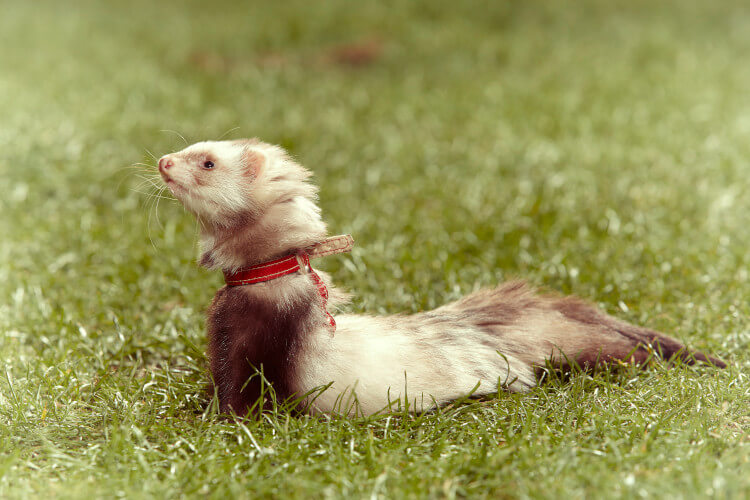
These ferrets, however, require proper quality care for them to reach their full potential.
This article delves into what Angora ferrets are, their characteristics, and how they can be best-taken care of.
Origin of the Angora: Ferrets of a Different Breed
Angora Ferrets are an emerging breed of ferrets originating in Europe that have only been around the last few decades.
This undoubtedly cute species of ferrets was first realized at a breeding facility in Scandinavia.
Angora ferrets were characterized by a mutation that had them growing long hair on their rumps, and further selective breeding pushed for the emergence of the angora ferret species. This distinguishing coat is believed to be able to grow up to 6 inches in length.
Breeders in the UK have, over the years, given special attention to improve the Angora ferret and breed healthier lines.
Currently, several angora lines go back over 10 generations.
Distinguishing Characteristics of an Angora Ferret
Angora Ferrets mostly share the same characteristics as regular ferrets.
However, there are observable differences in their behavior and mostly appearance.
Angora Ferret Fur and Coat
The most noticeable and distinctive difference for Angora ferrets is their long fur coat that can grow up to about 6 inches in length.
Angora ferrets also tend to have no undercoat, as the undercoat is almost similar in length to the topcoat. Given the lack of an undercoat, these ferrets tend to have sparse hair growing on their tails.
The absence of this excess hair makes them less of a problem when it comes to shedding hair. As a result, the hair on Angora ferrets tends to be shorter during summer and longer during winter.
This hair may take some time to reach its entire length.
Angora Ferret Shape and Size

Angora ferrets can also be considerably sized in varying sizes and shapes, and they can weigh up to 7 pounds. They also come in various colors, but a combination of black and white is the most common.
They can also be black, albino, sable, champagne, black sable, chocolate, cinnamon, and white (with dark eyes).
They are also proven to have more potent energy levels than other ferret species. Unfortunately, this energy can make them a bit of a nuisance and make them agitated, which means they can quickly nip you while handling them.
These ferrets lack a cleft palate but have a cleft on the sides of their noses. This aperture gives the nose a distinctive fold, making it look moderately up-turned. Therefore, it can be used as an identifying characteristic.
Tufts of hair may be found on this ferret’s nose. However, experienced breeders can closely manage mating to normalize these features, which makes them slightly hard to notice.
Full-blooded Angora females quite notably have a difficult time nursing their kits to term completion, as their milk tends to dry out quickly. This has necessitated the inclusion of standard ferrets in their breeding to try and rectify this apparent issue.
Cost of the Ferret: Angora Prices
Angora ferrets are believed to have a high value, given their reputation and rarity.
The cost of purchase will likely vary depending on the color, gender, and the relevant breeder. Consequently, getting a ferret will cost you anywhere from $70 to $250, depending on the breeder’s quality standards.
Pet owners will also need to take into consideration the long-term cost implications.
These costs include annual vaccination, feeding, housing, spaying, and neutering.
Care for Your Angora Ferrets Pets
Food for Ferrets: What does an Angora like to eat?
Much like their ancestors, angora ferrets are carnivorous and mostly dine on meaty foods. However, their digestive system has difficulty processing plant food, and these foods should therefore be avoided.
Proper feeding for these ferrets translates to a long and healthy life for them. Therefore, their meals should primarily contain protein content, supplemented by a bit of fat and fiber.
Angora ferrets have short digestive tracts and should have a steady supply of food pellets throughout the day. Therefore, these ferrets do best with foods such as chicken, turkey.
Ferret Cages: A Home for Your Angora
It would be ideal if angora ferrets were housed in a ferret cage due to their curious nature. These cages are designed to be robust and still deliver the required comfort.
These cages should also be able to cater to the energetic needs of these ferrets. Experts recommend that angora ferrets are housed in moderately large and spacious cages allowing them their freedom.
A multi-floor cage allows you to set up toys and activities for your ferret, allowing them to enjoy their home. It will also enable them to get the amount of exercise they require with ease, keeping them healthy.
Ferret Grooming: Angora Requirements
Much like the standard breeds, Angora ferrets do not require a lot of special care and grooming. This is because the structure of Angoras fur has the top coat and under coat being almost similar in size. As a result, they do not shed much hair making it easy to clean up after them.
Angora ferrets have a musky smell, just like other ferrets, which can be managed by properly cleaning up their housing. In addition, a little grooming, ear cleaning, and occasional bathing can be done to keep your Angora ferret’s radiance.
Life Span of an Angora
Depending on the amount of care these ferrets receive, their lives can span between 6 to 10 years. However, early neutering curtails proper hormonal growth, significantly limiting the ferret’s life span.
It would be ideal if these procedures were carried out after reaching the one-year mark. But, unfortunately, these ferrets are prone to genetic health complications such as insulinoma, lymphoma, and adrenal disease.
They are also susceptible to parasites and digestive issues. These problems can, however, be avoided through proper feeding, grooming, and vaccination.
Bottom Line: Does an Angora Make a Good Pet?
Angora ferrets are a unique and exotic breed that is extremely easy to care for. They are ideal pets that can give complimentary companionship to their owners.
With proper care and sustenance, these ferrets can bring life to your home and allow you to easily enjoy the accompanying benefits these pets have to offer.

